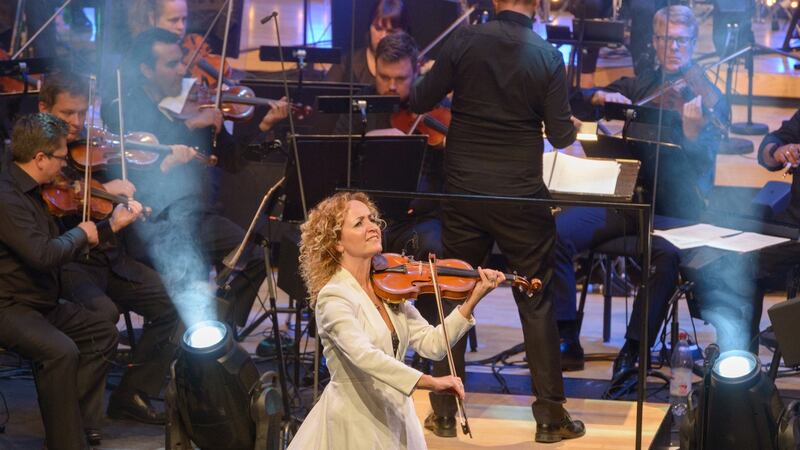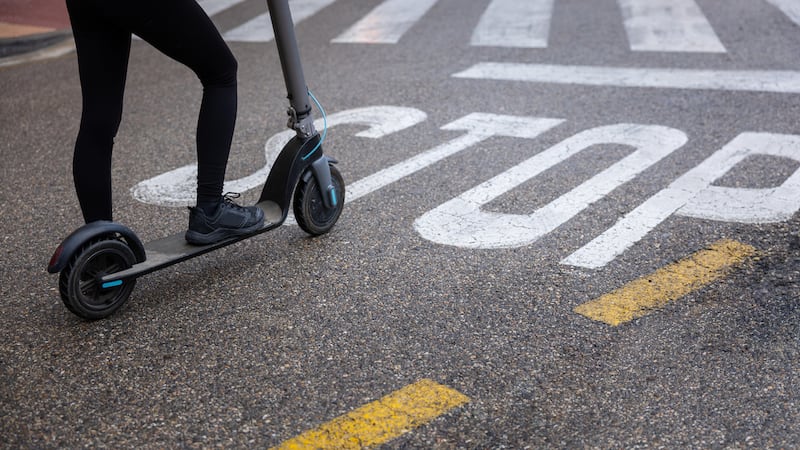It was just like every other morning when I take our dog out to get the newspaper. Except this particular Monday morning, as I pulled our dog away from another dog, I turned too quickly and fell on the uneven pavement outside a shop on Shelbourne Road in Dublin, near where we live.
I knew instantly that I had broken bones in both my arms and that my career as a violinist was in jeopardy. I knew they were broken because the horrendous pain was similar to when I broke my left shoulder 20 years ago. At that time, I was told I would never play the violin again, but after one year’s rehabilitation, I did.
After I fell, I knew the most important thing to do was to try to stay conscious until I got to the hospital. My dog Yogi was waiting beside me and I needed him to be taken care of before I could get into an ambulance. Some kind people stopped to help. I managed to give one my husband’s phone number to ask him to come and someone else called for an ambulance.

Lying on the pavement, it’s funny what goes through your head. I was thinking how amazing it was I could even remember my husband’s phone number as I only ever use speed dial and I was also thinking how cold the pavement was on that winter morning. I kept counting in my head to try to not think about the potential damage that had been done.
Operate immediately
My husband, Bernard Doyle, arrived and took Yogi home and I was taken by ambulance to St Vincent's hospital. I had X-rays and CT scans immediately. I had broken five bones in my lower right arm and the bone in my left elbow. Luckily for me, there was an amazing orthopaedic surgeon, Dr Paul Curtain, on duty. He knew that I was a violinist and decided that he had to operate immediately. I was four and a half hours in surgery.
Two plates and several screws were put in my right arm and two plates and six screws in my left arm. The big issue was whether I would be able to play the violin again. The plates helped to stabilise everything but the key question was how fast my arms would heal. I contacted Dr Marie Elaine Grant, the renowned physiotherapist, who had rehabbed my shoulder back in 1996. She is a member of the World Olympic Council with wide experience working with elite athletes.
Her hard work with me then got me back to playing with full movement despite all the odds. I rang her the night of the accident and said, “It’s round two, we’re on again.” The next morning, I discharged myself from hospital and decided my plan of action. I knew that I would manage myself better at home with home help and the support of my husband. At this point, I couldn’t even turn on a light switch, change the television channel or hold a book.
For weeks, I couldn’t shower on my own, dress or apply make-up. Every day, to keep sane, I tried to do something new – it’s amazing how crafty you become and my feet came in handy for switching on lights.
Two weeks after the surgery, I started rehabilitation. I went to the gym of a friend, Pat Henry, every morning and I went to Marie Elaine's physiotherapy clinic in the afternoon.
I spent a fortune on taxis – it was months before I could even try to drive again. I knew the key was to keep as fit as possible. I also felt it would be the quickest way to get through. You could lie on the couch and cry but it was an absolute necessity for me to avoid getting depressed.
Painful
The physiotherapy was so tough, it made the breaking of the bones seem less painful. Marie Elaine pushed me beyond the pain barrier and back again. Every physiotherapy session felt like 10 workouts.
I have a very high pain tolerance built up over time from being very accident prone – with all these breaks, I must be the most scarred violinist ever.
I took painkillers before the physiotherapy sessions but I also used mindfulness. I learned that instead of resisting the pain, it’s best to go with it. I also started back into yoga.
I learned a particular form of yoga, designed by an 81-year-old woman Vanda Scaravelli called "Awakening The Spine". It was important for me not to put any pressure on my arms when I did yoga. I had check-ups with the orthopaedic surgeon every two weeks. As I had started rehabilitation weeks before it was recommended, he was amazed to see that I had made very good progress.
I felt if I hadn’t taken this approach, I would not have been able to play the violin again. Classical music training is very disciplined so I was prepared to put in the hard work. From March to May, I just kept up this routine of the gym in the morning and physiotherapy in the afternoon.
Afterwards, I’d come home and sleep on the couch. In May, I took the violin out to try to start playing again. But I quickly realised that the plates in my right wrist were blocking the movement of my right bow arm. I reached a wall.
It was risky to consider surgery at this point as the tendons and nerves had grown over the plates which meant that with surgery, I could lose the power in one of my fingers. Yet, on May 13th, 20 years exactly after my band, Secret Garden, had won the Eurovision Song Contest for Norway, I had surgery in St Vincent’s Hospital with Dr Kieran O’Shea, a specialist in wrists, arms and shoulders. I was super fit and had started running again so I was ready.
I decided to have all the plates and screws removed at the same time, even though it was not the favoured option of the surgeon who inserted them.
The day after this surgery was the blackest day for me. I went straight to Marie Elaine to see if the range of movement had improved but it was not what we had hoped. I realised that I couldn’t play exactly the way I used to. I had to teach myself new techniques to hold the bow slightly differently. I decided that I wouldn’t go back on stage unless I was able to play at the same level that I could play before.
After the fall, all our work was cancelled except for three special 20th anniversary concerts scheduled for the end of May and I realised these had to be re-scheduled for the end of August. Then all my energy had to go into preparing for these three live concerts with full symphony orchestra and guest artists.
Rehearsing
I started rehearsing every day so that I could build up to five to six hours by July. The concerts would be over two hours long and I would need enough stamina to be on the stage for three concerts over two days.
I took multivitamins and I ate lots of fish and organic vegetables as I always do. I cook everything from scratch and don’t eat any processed foods. I continued running, working out in the gym, and going to my physiotherapy .
I also contacted a performance enhancement trainer, Sean Connolly, because I needed to get my confidence back mentally. One-third of what I needed was mental strength. I needed to feel very secure. The danger is that I might fall again due to nervousness.
In the last month before the concert, I did Qigong and positive psychology training with Sean to prepare me for going back on stage. I find performing terrifying on a normal good day so these circumstances put extra pressure on me. My husband was also with me full-time, taking care of me as well as my family. It’s not possible to get through something like this without having a team of people around you.
Everything was built towards these concerts in Norway at the end of August and, thankfully, they went really well. The audience was amazing.
It was a real sense of achievement. During all that time I was constantly asked if I thought I would play again and every day I said to them and myself it’s not an option not to play. That was my personal mantra and the goal was to be on the stage again by the end of August.
I was also approached by solicitors and others, advising me to take a case because I can still see the crack in the pavement where I fell. But I’d never take a legal case like that because I just think the resulting money would not bring any good.
I’m a very independent and driven person but during my recovery, I had to rely totally on other people. Your dignity goes out the window. I kept saying, “there has to be a reason for this” but I don’t have any profound testimony.
I’ve just realised that I’m far stronger than I thought I was. I had to let go and work through it.
I learned a lot of patience. After the concerts in Norway, I took September off and we went to France.
On September 30th, I had the last operation on my left elbow to remove the final set of plates. In October, I had the stitches removed so for the first time since February, I can lean on my elbow again. Now, I can start going forward again. I have concerts in Korea this month and a tour to Taiwan and Japan in January/February 2016. After that, I don’t know. I’d like to do some projects in Ireland. I’m just happy to have my arms back and be able to play again.
Fionnuala Sherry is a classically trained violinist and worked with the RTÉ Concert Orchestra for 10 years. In 1995 she won the Eurovision for Norway with the group, Secret Garden, which she formed with her musical partner Rolf Lovland.














